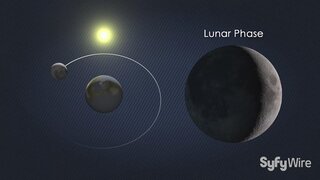Create a free profile to get unlimited access to exclusive videos, sweepstakes, and more!
The Moon's shadow shapeshifts during rare hybrid solar eclipse
This is the Action Comics #1 of solar eclipses.

The 2000 science fiction film Pitch Black opens on a ragtag group of spacefarers, a few minutes before they crash land on a deserted planet. The survivors find themselves bathed in perpetual light, thanks to the world’s three suns. That’s actually a good thing for their long-term survival, because the world is inhabited by a species of subterranean predators who won’t come to the surface during the day. And it’s always daytime, except for during a rare solar eclipse which temporarily blots out the suns.
On Earth, solar eclipses are already rare, and we only have one star to deal with, but some eclipses are even rarer than others. There are three common (we’re using that word loosely here) types of solar eclipse. The most famous is the total solar eclipse, that’s the one everyone wants to see. During a total eclipse, the Sun and Moon are the same apparent size in the sky and their orbits line up so that during totality, all but the Sun’s corona is obscured from view. Next are partial eclipses. These happen when the orbits don’t quite line up and the Moon just misses blocking out the Sun. Last are annular eclipses. These occur when the orbits line up, but during the most distant part of the Moon’s orbit. As a result, the Moon’s apparent size is too small to block out the Sun and a “ring of fire” remains visible around the edge.
RELATED: Incredible video of a solar eclipse… from the surface of Mars!
Partial eclipses are most common, accounting for roughly 35% of all solar eclipses. Annular eclipses come in second, with about 32%, and total lunar eclipses make up another 30%. The remainder, just a small fraction of the total, are a special type known as a hybrid eclipse. They happen somewhere on Earth only about once a decade, and today's the day.
We typically define an eclipse by how it appears to us from the surface of the Earth, but there’s another way to look at them. If you zoom out, the type of eclipse you’ll see from the ground is determined by what portion of the Moon’s shadow is hitting you. During a total eclipse, the darkest part of the Moon’s shadow (known as the umbra) hits the Earth. You’re completely in its shadow and you know it. During a total solar eclipse, observers on the ground might experience a noticeable drop in temperature along with an unnatural daytime darkness.
During a partial eclipse, the Earth is struck by a thinner peripheral shadow known as the penumbra, but never gets inside the Moon’s umbra. During a hybrid eclipse, however, both the penumbra and the umbra hit the Earth at different times. Because the Earth is curved, and because the Earth, Moon, and Sun are all in motion, the Moon’s shadow can sometimes transition from penumbral to umbral and back again during an eclipse. That’s a hybrid eclipse, and that’s what happened today.
RELATED: World’s oldest solar eclipse footage reappears, and it look like a real-life Melies movie
The path of the eclipse traced a line southwest around the northern curve of Australia (if deadly subterranean predators are hiding out anywhere…) beginning at 1:34 a.m. UTC today. The eclipse transitioned from partial to full at 2:37, reached maximum at 4:17, and transitioned back to partial at 5:57 a.m. UTC. The final curtain call happened just before 7:00 a.m. UTC this morning.
If you missed it, your next opportunity is Nov.14, 2031. Although, you’re going to need a boat. Most of the eclipse is going to happen over the middle of the Pacific.
In the meantime, catch up on Pitch Black and the entire Riddick mythos, available from Universal Pictures.



























